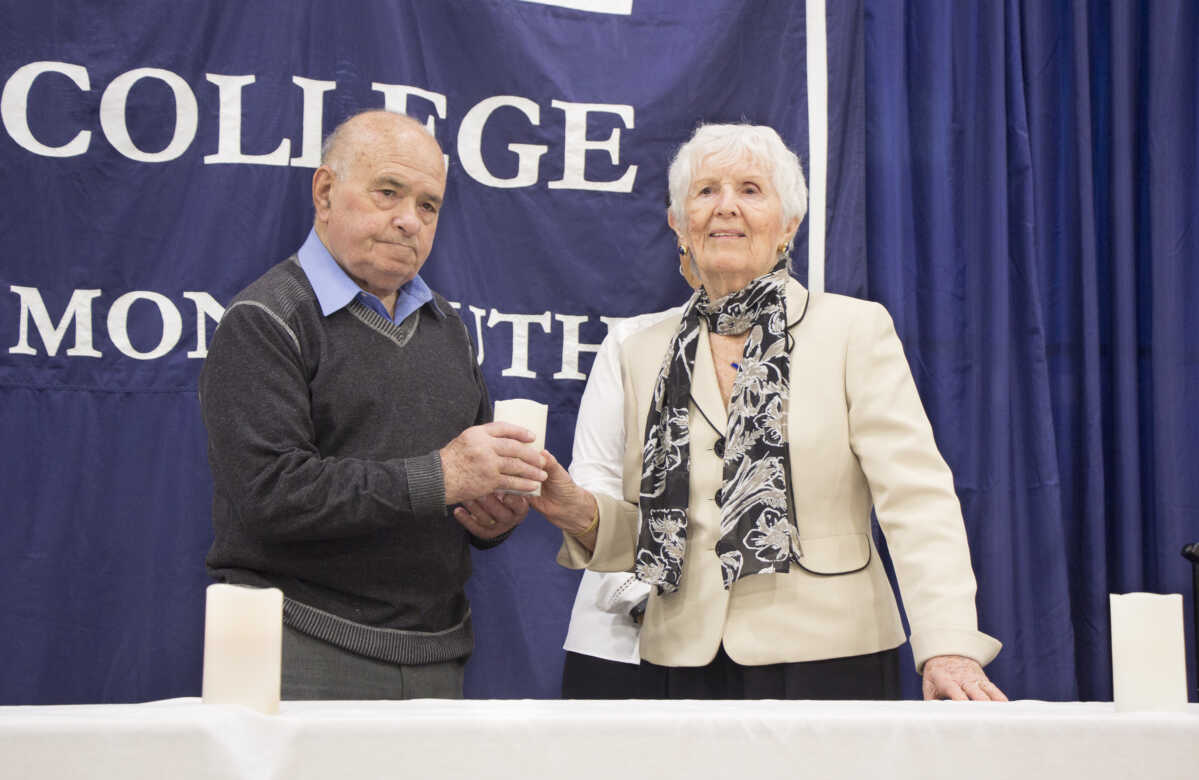Yom HaShoah Ceremony Honors Local Holocaust Survivors
May 9, 2016

For today’s educators and advocates, it can be difficult to convey the true impact of the Holocaust to younger generations. The pure statistics – six million European Jews murdered, including 1.5 million children, between 1933 and 1945 – are so daunting that they can be almost impossible to grasp.
Instead, historians like Dr. Samuel Kassow and groups like the Center for Holocaust, Human Rights and Genocide Education (Chhange) at Brookdale often focus on individual stories, the first- and second-hand accounts of survivors and surviving family members that shed light on the true scope of loss felt by Holocaust victims.
That theme was at the heart of Chhange’s 2016 Holocaust Remembrance Day – or Yom HaShoah – ceremony, held on the Lincroft campus on May 6.
“How do we convey the enormity of the Holocaust?” asked Chhange executive director Dale Daniels, addressing hundreds of local students and community members gathered in the BREC auditorium for the program. “We often quote numbers, but numbers do not have a name, and a face, and loved ones.
“Rather, it is when we focus on the compelling human story behind this event and we make that connection to individuals, when we hear testimony from our survivors, it is then that we are able to begin understanding the devastating loss and inhumanity that is the Holocaust. The human story is the core of Chhange’s teaching, and it is one of the reasons that Dr. Kassow is here today.”
Kassow, a noted historian and professor of history at Trinity College, authored the 2009 book Who Will Write Our History? Rediscovering a Hidden Archive from the Warsaw Ghetto, which details the efforts of Emanuel Ringelblum and dozens of Holocaust victims to create and preserve a historical record of their lives in the Warsaw Ghetto during World War II.
Delivering the keynote address for the Yom HaShoah ceremony, Kassow explained how Ringelblum’s group – code-named Oneg Shabbat – encouraged Jews of all ages to record “real-time testimony” of their lives, impressions, hopes, fears and daily experiences in the ghetto.

Dr. Samuel Kassow speaks during Chhange’s Yom HaShoah commemoration at Brookdale on May 6.
“Ringelblum said, ‘Write everything down now. Everything you see, write it down. Don’t wait. You don’t know what will happen tomorrow,'” Kassow said.
Those testaments included essays written by young children describing what they hoped to do after the war was over. Others describe communal efforts to match starving children up with surviving families who could provide food.
One testimonial, written by a Warsaw mailman, described how the Germans left a group of Jewish toddlers on a couch in the middle of the street, each of whom were screaming for their mothers. Any resident who approached the toddlers to provide food or water was badly beaten, the author wrote.
“‘They could have just removed the couch,'” said Kassow, reading from the mailman’s essay. “‘But they kept it there, just so we Jews could suffer just a little bit more.'”
Thousands of testaments like these, along with letters detailing the lives and aspirations of Holocaust victims and their family members, were collected and ultimately buried by members of the Oneg Shabbat collective before the Warsaw Ghetto was dismantled in 1943. The documents, hidden in metal boxes and milk cans, were discovered separately in 1946 and 1950.
“By a miracle, all of these testaments survived,” Kassow said. “[Oneg Shabbat member] Israel Lichenstein wrote, ‘I have given my whole life to this archive. I want to be remembered. I want my wife to be remembered. She is an artist… I want my daughter, Margalit, to be remembered. She is 20 months old but she equals four-year-olds in intelligence.’
“In his last months, Lichtenstein reminded us that these Jews were not anonymous, faceless victims. They were people with names who wanted to be remembered. They were also part of a resilient and proud nation. And this is the real legacy of the Oneg Shabbat Archive.”
The spotlight then turned to 14 local Holocaust survivors, who were welcomed on stage in pairs to light one of seven ceremonial candles in honor of the millions who lost their lives during the Shoah. As they were escorted to the stage by U.S. Navy personnel from Naval Weapons Station Earle, Chhange members Eva Wiener and Mimi Werbler narrated each survivor’s personal history during and after the war.
Honorees included Issac Kaufman, who was born in Poland and confined to a ghetto before being sent to a labor camp in 1940. Kaufman was ultimately imprisoned in seven different camps before being liberated from Dachau in 1945.
“He was the only member of his family to survive, and he arrived alone in the United States – in Bayonne, New Jersey – in 1951,” Werbler said.
The Yom HaShoah ceremony also featured performances by the Marlboro High School Chorus and String Quartet, as well as addresses by Brookdale President Dr. Maureen Murphy and members of the Jewish Federation in the Heart of New Jersey, which offers services to area Holocaust survivors.
“The history of the Holocaust is not a lesson from the past. It is also a lesson for our future,” said federation executive vice president Susan Antman, a child of two Holocaust survivors who reminded the audience that apathy and ignorance can be just as dangerous as hatred.
“The monsters were few, but those ready to help them or pretend that nothing worth noticing was happening, were plenty. This is what we need to be deeply mindful of, even today. We must guard against humanity ever losing its humanity again. By being here today, we are all doing that.”
